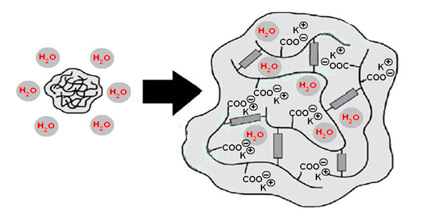WHAT IS HIDROSILO?
HIDROSILO is a superabsorbent polymer (SAP) developed specifically for agriculture and solidification of liquid residues for cultivation. Its main characteristic is to store water within its reticulated polymeric structure. HIDROSILO has the capacity to absorb more than 300 times its weight in water and thus maintain moisture in the soil for a long time. When in contact with water, it turns into a gelatinous substance known as HIDROGEL. The water stored in HIDROGEL is available to the roots of the plants, allowing them to perform their metabolic functions. After releasing its water, the HIDROSILO returns to its original state, remaining functional for up to 5 years, depending on soil conditions, since it is biodegradable. It also has UV resistance superior to conventional SAPs, being able to be applied in places with a high incidence of sunlight, without causing HIDROGEL liquefaction or significant loss of swelling capacity.

HIDROSILO is basically constituted of crosslinked Poly (Potassium Acrylate-co-Acrylamide) with potassium content from 26% to 28%.
Typical HIDROSILO granules
HIDROSILO swelling process

HIDROSILO granule before and after swelling

Acrylic waste
recycling chain
Its main raw material are residues from textile fibers, specifically acrylic fibers produced with Polyacrylonitrile or PAN polymer, which can be recycled and transformed in a sustainable way into HIDROSILO. Acrylic fibers and the residues from their manufacturing process – when discarded in the environment – can take more than 100 years for their degradation. Therefore, the use of SAP-K for agricultural or industrial purposes helps to contribute to the environment by recycling textile waste and producing food with irrigation water savings.

